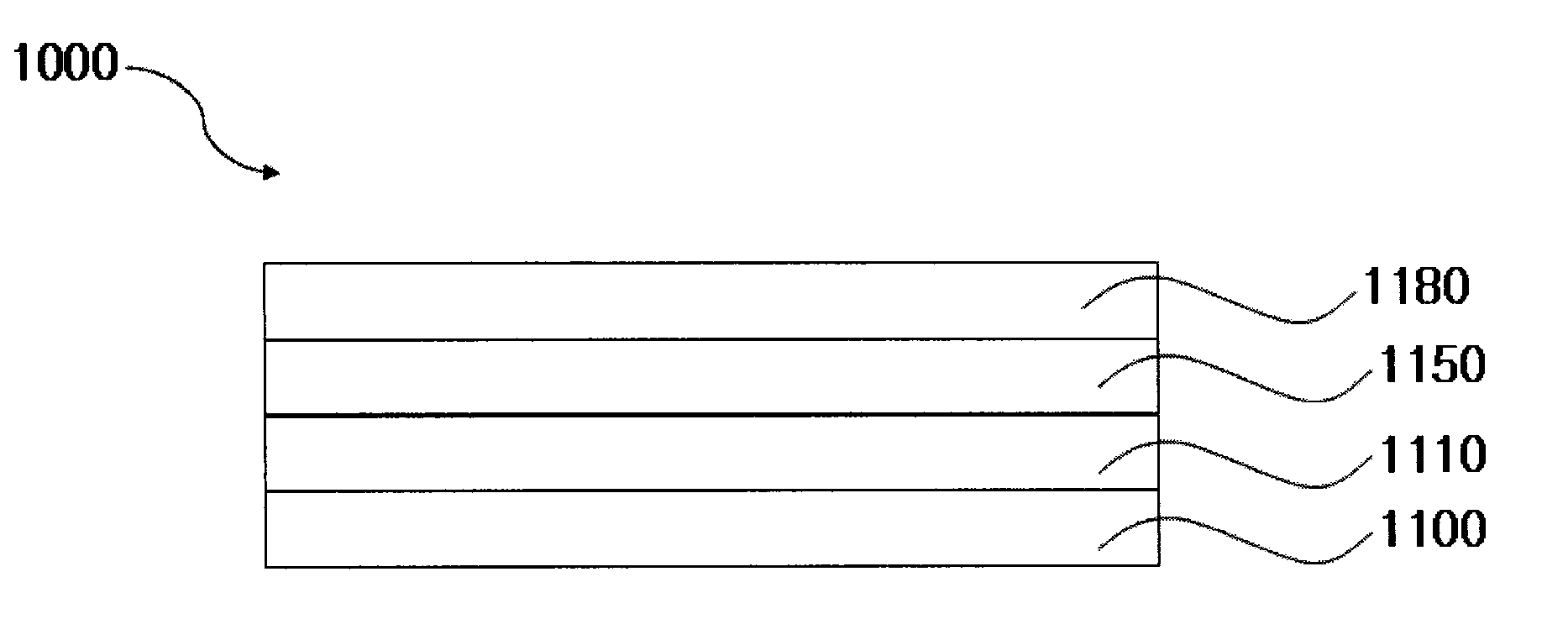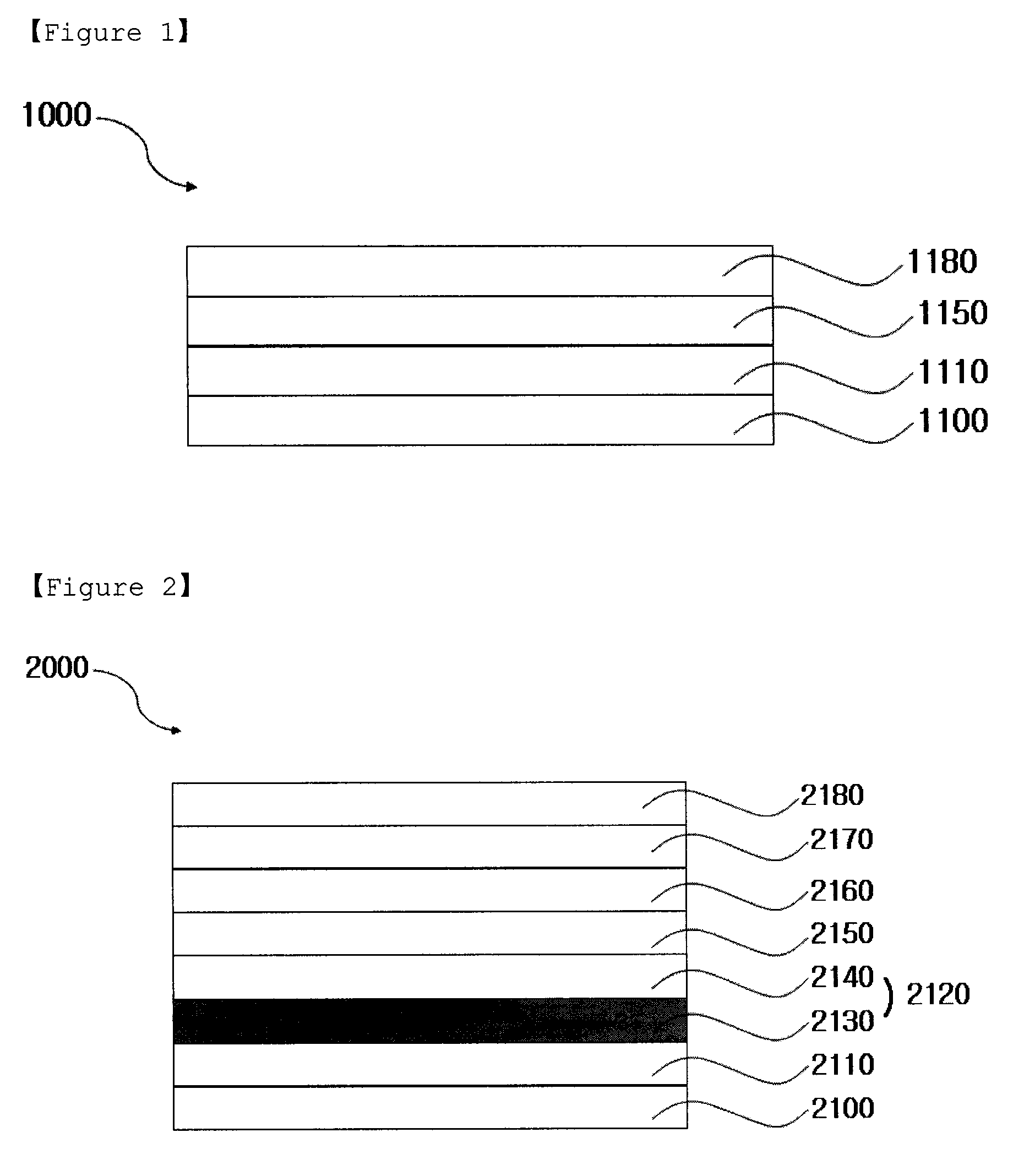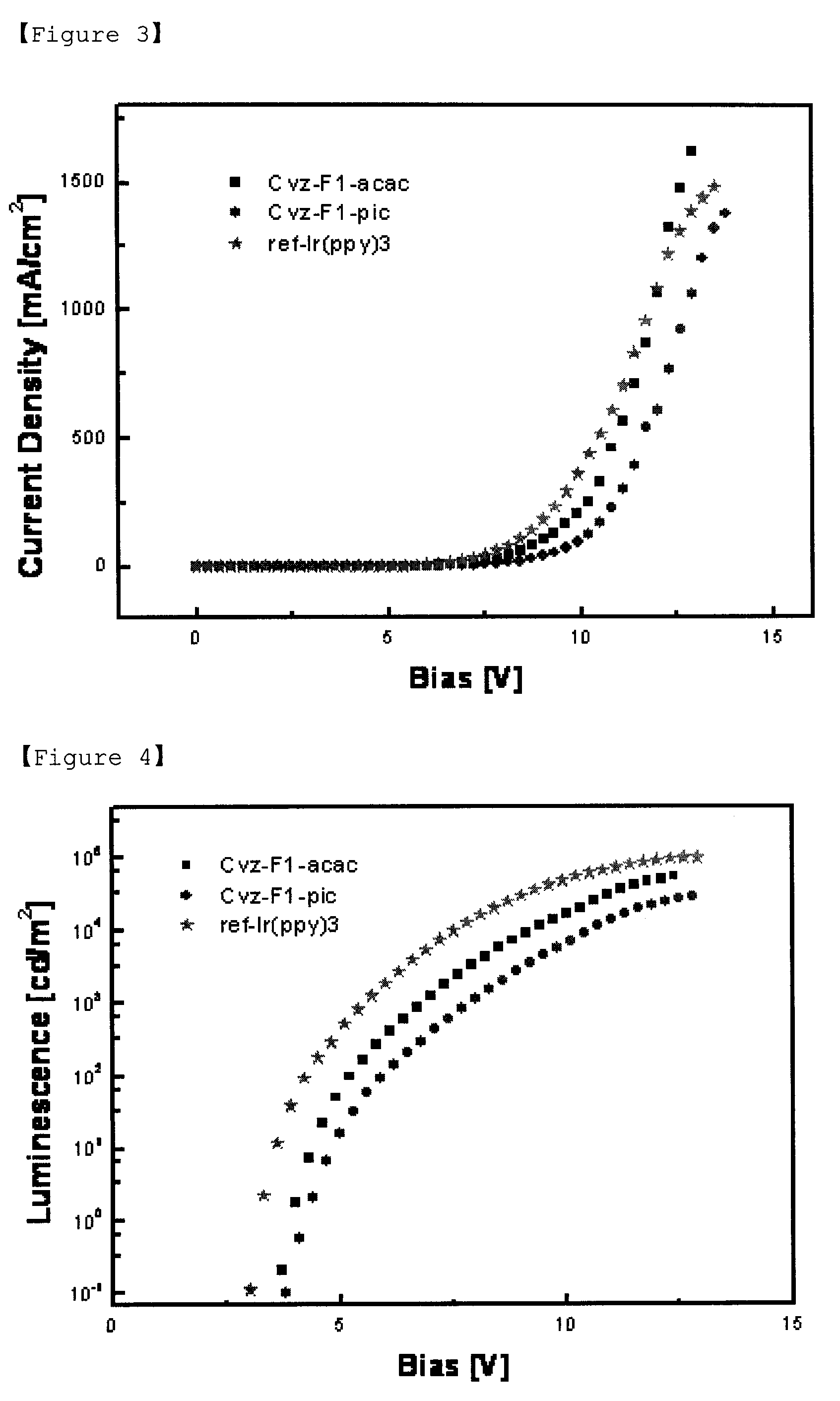Iridium complex containing carbazole-substituted pyridine and phenyl derivatives as main ligand and organic light-emitting diodes containing the same
a technology of carbazole substitution and pyridine, which is applied in the field of new iridium complexes with phosphorescent properties and organic light-emitting diodes containing the same, which can solve the problems of color coordinate and lifespan that is still not developed
- Summary
- Abstract
- Description
- Claims
- Application Information
AI Technical Summary
Benefits of technology
Problems solved by technology
Method used
Image
Examples
preparing example 1
Preparing of 9-(2-chloro-pyridine-4-yl)-9H-carbazole
[0086]
[0087]2,2′-dibromo-diphenyl (8.73 g, 27.99 mmol), 2-chloro-4-aminopyridine (3 g, 23.33 mmol), sodium tert-butoxide (5.38 g, 55.99 mmol), which is a reaction catalyst, and tris(dibenzylideneacetone)dipalladium(0) (1.07 g, 1.17 mmol) are mixed in a one neck round flat flask having a volume of 100 ml. Gas of the flask containing the mixtures is removed by using liquid nitrogen and toluene (50 ml) purified under nitrogen is added. Thereafter, it is reacted at room temperature for 10 minutes. Next, Tris-tert-butylphosphine (9.49 g, 4.67 mmol), which is another reaction catalyst, is additionally added, the reaction mixture is refluxed (110° C.) for approximately 48 hours, and whether the reaction completes is confirmed by a TLC. Thereafter, the reaction mixture is cooled at a room temperature and an organic layer is washed by using diethylether (200 ml) and brine (3×20 ml).
[0088]Water remaining in the organic layer extracted by sod...
preparing example 2
Preparing of 9-[2-(4-fluoro-phenyl)-pyridine-4-yl]-9H-carbazole
[0089]
[0090]The 9-(2-chloro-pyridine-4-yl)-9H-carbazole (2 g, 7.18 mmol) obtained in the above preparing example 1 and 4-fluorophenylboroic acid (1.20 g, 8.61 mmol) are put in a one neck round flat flask having a volume of 100 ml and are mixed with tetrakis (triphenylphosphinopalladium) (1.20 g, 8.61 mmol) that is a reaction catalyst. Toluene (70 ml) purified under nitrogen is added in the flask containing reagent. Gas of the flask containing the mixtures is removed by using liquid nitrogen (twice to three times). Thereafter, 2M sodium carbonate aqueous solution (23 ml) and ethanol (4 ml) are additionally added by using a syringe under nitrogen. Herein, the sodium carbonate acts as a base during the reaction. The reaction mixture is heated at 80° C. for 12 hours and whether the reaction completes is confirmed by a TLC. Thereafter, the reaction mixture is cooled at a room temperature and an organic layer is washed by usin...
preparing example 3
Preparing of 9-[2-(2, 4-difluoro-phenyl)-pyridine-4-yl]-9H-carbazole
[0091]
[0092]9-(2-chloro-pyridine-4-yl)-9H-carbazole (2 g, 7.18 mmol) and 2,4-difluoro-phenylboroic acid (1.36 g, 8.61 mmol) are put in a one neck round flat flask having a volume of 100 ml and tetrakis (triphenylphosphinopalladium) (0.25 g, 0.22 mmol) that is a reaction catalyst is put therein. Toluene (70 ml) purified under nitrogen is added in the flask containing reagent. Gas of the flask containing the mixtures is removed by using liquid nitrogen (twice to three times). Thereafter, 2M sodium carbonate aqueous solution (23 ml) and ethanol (4 ml) are additionally added by using a syringe under nitrogen.
[0093]Herein, the sodium carbonate acts as a base during the reaction. The reaction mixture is heated at 80° C. for 12 hours and whether the reaction completes is confirmed by a TLC.
[0094]Thereafter, the reaction mixture is cooled at a room temperature and an organic layer is washed by using diethylether (200 ml) an...
PUM
| Property | Measurement | Unit |
|---|---|---|
| internal quantum efficiency | aaaaa | aaaaa |
| quantum efficiency | aaaaa | aaaaa |
| thickness | aaaaa | aaaaa |
Abstract
Description
Claims
Application Information
 Login to View More
Login to View More - R&D
- Intellectual Property
- Life Sciences
- Materials
- Tech Scout
- Unparalleled Data Quality
- Higher Quality Content
- 60% Fewer Hallucinations
Browse by: Latest US Patents, China's latest patents, Technical Efficacy Thesaurus, Application Domain, Technology Topic, Popular Technical Reports.
© 2025 PatSnap. All rights reserved.Legal|Privacy policy|Modern Slavery Act Transparency Statement|Sitemap|About US| Contact US: help@patsnap.com



